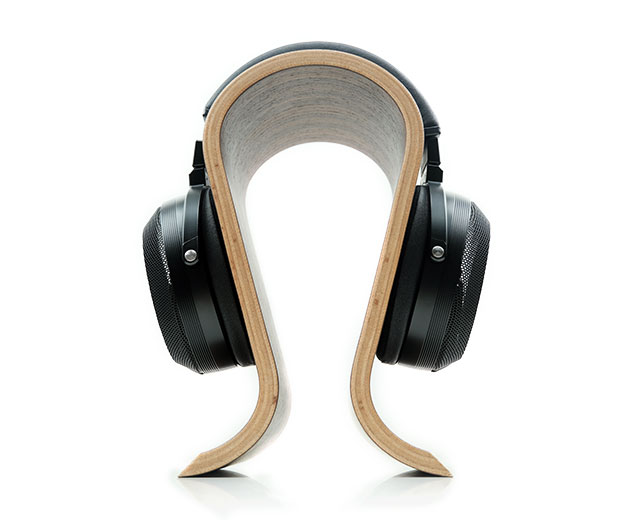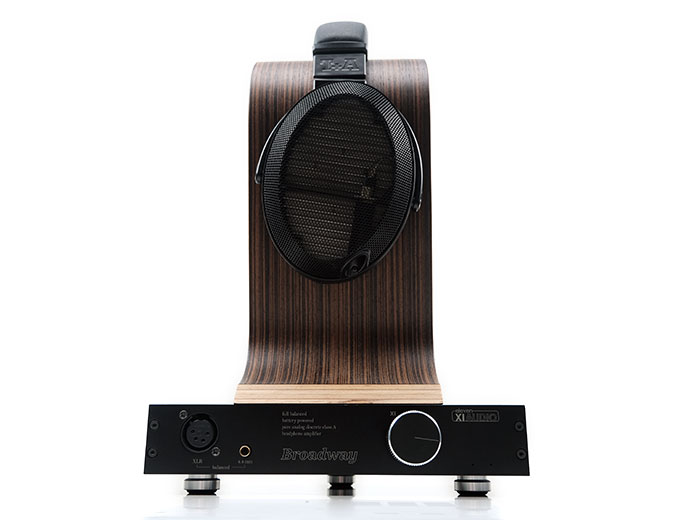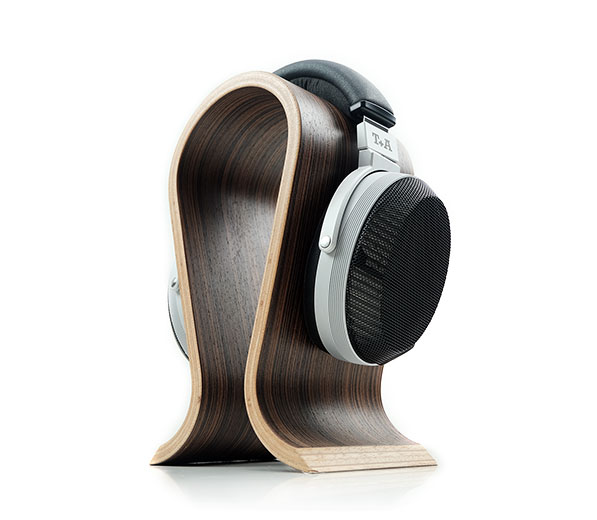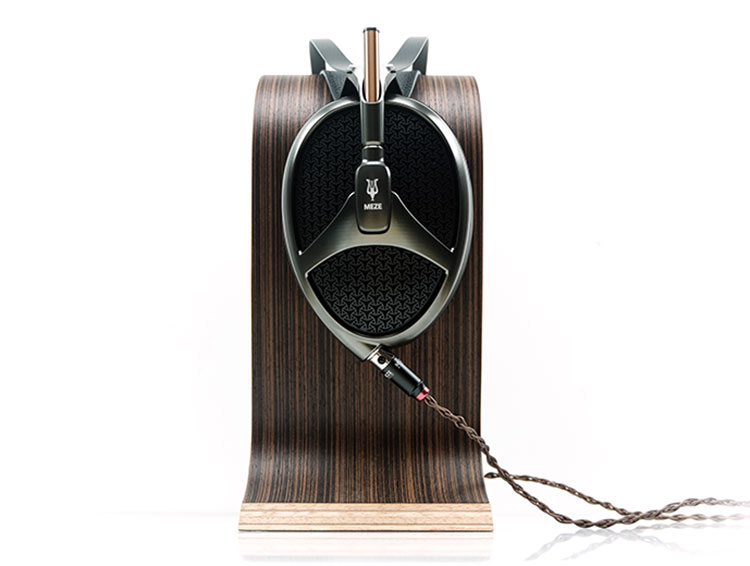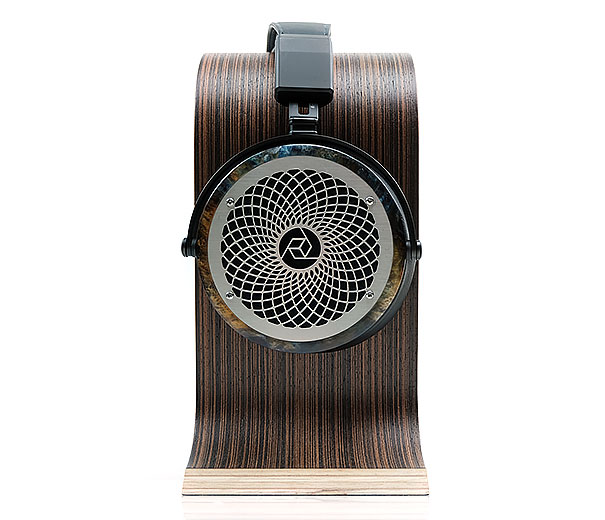Solitaire P-SE Sound Impressions
Summary
The P-SE is a masterclass in effortless articulation and shockingly good resolution. T+A has been at pains to point out this headphone is being tagged as planar-magnetostatic headphone as opposed to just plain planar and in a way, it does contain elements of an electrostatic sound.
From the unexpectedly fast transient response to very precise control and imaging, the P-SE does a hell of a job rendering some competing planar headphones as relatively sluggish and slightly smeared sounding. Especially so through the mids where the comparative control of space and precise imaging is scary good.
This is not the most powerful sounding ‘planar’ headphone I have heard though, perhaps another trait of incorporating that magnetostatic moniker in the way it artfully ‘presents’ bass rather than ‘ram it’ home.
The Solitaire P-SE does extend very well in both directions with some very tangible layering but the quantity level on the low-end is less than say the Empyrean, RAD-O, and even the flagship Solitaire P. All three have a bit more physicality or warmth from the low-end that generate a bit more ‘oomph and instrumental body.
The P-SE offers a relatively mild bump around 50-100Hz but nothing substantial before settling down into that classic linear planar bass response right up to 1k. From there to 5-6k it dips to around 2k then rises slightly to around 4-5k remaining fairly energetic throughout the treble and peaking around 8-10k.
Timbre
This is a cleaner sounding headphone with a relatively neutral and accurate timbre up to the mids and a slight bias to upper-order harmonic dominance through the upper mids. The transparency from the P-SE is very good actually with both source and amplifier matching capable of tweaking this general tonal description.
My own personal preference was to go with something analog and smooth in delivery such as an R2R DAC or a relatively meaty and smooth solid-state as well as a traditional SET amplifier. Here, the P-SE’s harmonic balance is incredibly balanced and accurate rather than euphonic or lush.
On brighter sources, I found the P-SE would pick up quickly on that tonal switch-up with an upper mids timbre and treble mix that sounded a little less forgiving or harsher in its delivery. You want to avoid that as it can draw your ear too far up the FR with some minor harmonic dissonance from emphasized sibilance from vocals and percussion.
Overall, the timbral weight of the P-SE for instruments and vocals errs to the light and pristine so those looking for a heavier fundamental would be better served grabbing the flagship P which offers a weightier bottom end to instrumental strikes and male vocals.
Staging
This is where the peak of the Solitaire P-SE powers resides. The level of clarity and resolution in the staging performance is just outstanding.
Now, this is not a vast soundstage such as you will find from the HEDD Audio HEDDphone. This is not about chucking out arena levels of staging size but rather the incredible accuracy and separation it can achieve within the staging size the P-SE afford you.
In terms of the sheer size, depth, and weight on the low-end, the P-SE sounds relatively neutral compared to its superior width and excellent headroom.
You will get more power elsewhere but what you do get instead is a beautiful level of definition and layering right down to 20Hz. You can easily pick out what is happening once you drop below the mids whether it is double bass plucks or kick drum placements.
That speedy transient response and impressive precision continues with some excellent separation and pinpoint imaging throughout the mids. Every note, every spatial cue is picked up by the P-SE with almost perfect timing.
Higher pitching vocals are slightly forward but overall this is not an intimate staging headphone, rather the control and amount of air allow for a very high level of vocal clarity.
If you are into complex musical arrangements you are going to be impressed by how easily the P-SE reproduces it. I have heard some wonderful timbral balances from the likes of the Empyrean but only the Final D8000 Pro comes close to the level of detail the P-SE delivers through the midrange and treble.
Synergy
Efficiency
The P-SE has a slightly more efficient rating than the flagship P at 45Ω compared to 80Ω so there is less of a demand for sources or amps with heavy-duty voltage swings. However, the current demand, and is relatively unchanged at 100dB SPL for both headphones.
Now I found that dB rating to be a little deceiving for current performance on our tested rigs. Headphones with similar SPL ratings such as the Meze Empyrean and the 98dB SPL rated Rosson Audio Design RAD-0 all required up to 6-7dB less volume on platforms such as the dCS Bartok with single-ended cable pairings.
For example, the Empyrean was quite comfortable at -30 to around -27dB with a 0dB gain setting. A similar experience also for the RAD-0, which was good around -25dB to -27dB. To get a similar performance from the P-SE I had to up the volume to around -19dB to almost -16dB.
One could argue that the lighter impedance rating of these two headphones at around 29-32Ω might play a very light role in some minor variation but not so much that you get that kind of dB gap. I think perhaps someone’s measurements are either too conservative or too generous.
The SPL performance of the P-SE was more in line with the Dan Clark Audio AEON 2/Ether 2 which are closed to 92-94dB SPL and with a very low impedance sub-15Ω.
Does that mean you cannot use a portable source with the P-SE? Well, yes you can with the likes of the HiBy R8 and the iBasso DX300/AMP11 combo. However, a high gain setting will be required and I still think 1-2W from a good desktop amp is going to get you better results in terms of dynamic range.
Pairings
Testing was done with a multitude of sources and amplifiers including the Hugo TT2, Musician Audio’s Pegasus R2R DAC, Violectric’s V281 and V590, Bakoon’s HPA-01, and the dCS Bartok.
What I did find was a strong personal bias to smooth and natural-sounding rigs rather than clean and energetic combos. What I wanted to do was inject a little more of a liquid overtone on the upper-mids timbre and treble energy of the P-SE without losing that vivid performance or level of clarity and detail it is excellent at.
Violectric V590/V281
For example, the Violectric V590 integrated amp/DAC with its dual AK4490EQ processing sounded excellent on the low-end, second only to the Bartok for depth and power. However, the treble was the edgiest of the sources tested although not by much.
By substituting the internal DAC for the Pegasus R2R DAC line-in suddenly the V590 amp with the P-SE was a lot smoother and calmer sounding to my ear with less treble energy, more physical vocal notes, and that all-important liquid timbre from the P-SE.
With the V281, the effects were quite similar though the low-end was a little more on the physical side. In fact, the P-SE low-end was probably a shade lighter with the V590 with the Pegasus R2R DAC but still managed to offer more body in the mids compared to the internal V590 DAC.
dCS Bartok
The Bartok and P-SE pairing gave me something in between the organic smooth sound of the Pegasus and the gustier low-end of the Violectric. The dynamic range was excellent with this being the best pairing for power and detail. If I do not need to push that lightish P-SE low-end too much I would still stick with the Pegasus as my main source, however.
Bakoon HPA-01
The Bakoon HP-01 with the iBasso DX300 lineout is also a very smooth and natural-sounding performer using the current mode output. The P-SE does sound a bit more relaxed through the mids compared to the other rigs but I did get a very nice sweet sounding timbre throughout.
Chord Hugo TT2/M Scaler
The final pairing was the Hugo TT2 with the M Scaler and oh boy, the detail shoved down the P-SE pipe was phenomenal. Not quite as analog-sounding as the aforementioned combos nor was it as weighty n the low-end so I would still give my preference for power to the Bartok and the V281 or V590.
However, in terms of articulation and clarity, this was perhaps the ideal setup for those who want to hear absolutely everything in their music. The P-SE loves detail and it could handle everything the TT2/Scaler combo could throw at it and not miss a single cue.
Select Comparisons
T&A Solitaire P
£5000
Technical
We have gone through a fair amount of contrasting points between the flagship P and the new P-SE up to this point so we will keep on the light side here.
The key technical difference is the dual-sided design of the P (TPM3100) versus the single-sided magnet array of the P-SE (TPM2500) driver. Both have similarly sized 110x80mm drivers with similar build processes so physically they look relatively similar when peering through the grill.
The switch to the single-sided design means impedance is also a little lower at 45Ω for the P-SE compared to the 80Ω rating on the P though efficiency overall on paper is the same at 100dB SPL. In our real-world testing on the dCS Bartok and Chord’s Hugo TT2, we found little difference in terms of volume matching between these two headphones.
Design
Both the P and P-SE offer full-sized open-back circumaural designs of median weight for planar headphones but with above-average pressure distribution and excellent comfort levels. The P-SE here has a slight edge being 90g lighter with its heavier use of lighter plastics compared to the CNC milled aluminum materials of the P.
The P-SE aesthetic is a little more subdued with a darker all-black tone compared to the mix of black and silver on the Solitaire P. I suspect some will prefer the ever-popular black headphone look.
Premium materials have been substituted to get the costs down on the P-SE including velour instead of Alcantara for the headband and cup lining but the wearing experience between these two is very similar aside from the weight difference.
The other big difference mentioned is the connector system with the use of a dual 3.5mm TRS entry system on the P-SE compared to the more expensive LEMO push-pull connectors on the P. I am relatively agnostic on the pros and cons of either system but the better color coding on the 3.5mm TRS connectors get my vote.
Performance
The gap between these two headphones is not huge which is comforting for those who simply do not have the budget to grab the flagship P. However, the Solitaire P, overall, has a more satisfying tuning with a weightier response curve compared to the P-SE that does make a bit of a difference in the overall harmonic balance.
From the top-end, the P-SE treble is not quite as solid, a little brighter and leaner compared to the P. This tends to creep down into the mids natural sibilance a bit more create a slightly sharper overtone.
I must emphasize this difference is nuanced and contextual. The P-SE is not a sharp-sounding headphone per se. Clean and clear, yes, but not unbalanced sounding. Rather, the P has more liquidity to its attack and a more pleasing timbre for naturally sibilant vocals and percussion mixes.
The better P balance, is in part, drawn from its firmer low-end which has more presence sub-50Hz and slightly less mid-bass emphasis. The P-SE sounds slightly rolled off in comparison sub-100Hz which means lower-register notes are not quite as weighty sounding compared to the P.
The P certainly has the edge in terms of power but that also means has a little more physicality in its notes throughout. The P-SE is lighter in body, perhaps more energetic sounding through the mids but a little more upper harmonic emphasis.
Meze Empyrean
$2999
Technical
The Empyrean was launched in 2019 and won our Top Gear Award for Best Headphone that same year. Both are open-back circumaural planar driver headphones but with some twists to the usual design.
Inside, the Empyrean uses an isodynamic hybrid array driver whereas the P-SE is a planar-magnetostatic driver. The Empyrean driver uses a split trace design which differs fairly radically from the P-SE single entity vapor-deposited membrane. The magnet array is also quite different in terms of application.
The Empyrean uses a dual-sided symmetrical placement of neodymium magnets to maximize the efficiency of its magnetic field. Further to that, the pads of the Empyrean have additional patented ferromagnetic plates inside for both attaching and further strengthening the magnetic field performance.
The P-SE reverts to a single-sided array of matching-shaped magnets in a precise alignment to ensure every aspect of the diaphragm is moving in a linear or uniform manner.
In terms of efficiency, the Empyrean is quite easy to drive at 31.6Ω compared to P-SE’s 45Ω but with a similar SPL rating of 100dB on paper. However, in our testing with our two amps, the Bartok and the TT2, the Empyrean was far easier to drive compared to the P-SE.
Our rough volume matching on the Bartok’s high gain level left us with an impression of around a 6-7dB gap between the two headphones.
Design
These are the total opposites in terms of aesthetics with perhaps the elongated cup approach being the only common denominator.
The Empyrean is flush with quasi-Persian design accents in its exquisite grill finishing as well as using an aluminum frame and leather pads, (velour pads additional free of charge). The P-SE is more minimalist with a monotone black and hard plastics finish as well as velour for the headband and pad internal walls.
The P-SE also uses a single band headband whereas the Empyrean uses the arching tensioner headband with a wide-area pressure strap underneath for balancing. The weight of both headphones is actually quite similar at 430g for the Empyrean and 440g for the P-SE. Yet, despite the radically different comfort approaches, both have excellent comfort levels.
The distributions are slightly different with the P-SE more on the sides, if any, compared to the greater top-down feel of the Empyrean but overall, these are two of the better performers when it comes to long-term listening comfort.
Performance
The Empyrean is the darker and warmer sounding of the two headphones. The P-SE places a lot of stock and emphasis on precise articulation and clarity whereas the Empyrean draws you in a bit more with its more rounded timbre, broader sounding texture, and generally offering more low-end body.
On the low-end, the Empyrean is relatively linear from 20Hz up to 1k, with a small mid-bass bump around 100-200Hz. The P-SE also has a decent bump around 50-100Hz but it is not huge and if anything its response curve flatter up to 1k.
The big difference is the sub-bass weight and separation with the P-SE rolling off a little compared to the Empyrean’s weightier delivery but offering slightly better layering. If you want more power and warmth up into the mids the Empyrean is the right choice. However, the P-SE has a superior bass definition with a quicker transient response.
Mids are more elevated on the Empyrean with a warmer more rounded timbre. Vocals are just stunning on the Empyrean in terms of euphonic richness and textural detail. The P-SE is more dipped from 1-3k, so it is positioned further back. However, the tone is clean and lighter overall with a very precise and fast-sounding delivery.
Treble Divergence
You will fall in love with the Empyrean midrange tonal ‘vibe’ but overall the P-SE delivers on the detail and complexity that bit better. Much of that has to do with the treble response which is where these two diverge quite a bit.
The Empyrean rolls off slowly from 5k onwards with only a slight nudge around 10k. This cuts off the headroom a little in favor of vocal prominence but also gives percussion a liquid rounded tone and pushes them slightly further back.
The P-SE extends gloriously from 3-4k onwards with more treble energy and presence offering a taller airier staging quality compared to the more intimate Empyrean.
Rosson Audio Design RAD-0
$2600
Technical
The RAD-0 is the debut circumaural open-back planar magnetic headphone by Rosson Audio Design. We reviewed it back in 2019 and it picked up a Writer’s Choice award also in 2019.
Inside, the RAD-0 uses a 66mm planar magnetic driver design with a proprietary array of 11 N52 magnets in a dual-sided configuration. The P-SE uses a larger elliptic 110x80mm driver with a single-sided magnetic array matched in length to the vapor-deposited oval diaphragm shape.
Specs on paper would indicate both are relatively easy to drive with a lower 29Ω for the RAD-0 compared to the P-SE’s 45Ω rating and a slightly less efficient 98dB SPL compared to 100dB for the P-SE.
However, on our two test amplifiers, we got similar efficiency results to the Empyrean when put up against the P-SE. The P-SE seems harder to drive, at least in terms of current or volume matching with around a 4-5dB gap between the two on the high gain from both the Hugo TT2 and the Bartok.
Design
Again, two very contrasting designs but this time the round cup and single-headband of the RAD are more conformist compared to the P-SE elongated cup shape.
Styling-wise both are very different with the RAD-0 eye-catching dyed cups design and Fibonacci-type patterned front grills. The P-SE is more ‘executive’ and understated with its all-black finish and flash of red covering the insides of the pads.
The P-SE is by far the lighter and comfier of the two in terms of pressure distribution. The RAD-0 uses a lot more aluminum and solid resin cup materials which, combined with that dual-magnet array, give it a fairly hefty feel at 650g.
To mitigate hot spots you get a lot more lateral pressure clamping behind some thick protein leather pads and a decent headband memory foam wedge which do a good job alleviating the pressure. However, it is still not as comfortable as the P-SE’s excellent pressure distribution and its lighter 440g frame.
The RAD-0’s rounded pads are also never quite as comfortable either as the P-SE’s elongated pads which do a better job of clearing all of your ears. You will get a bit more heat from the protein leather than breathable P-SE velour.
Both use a 3.5mm TRS locking system for cable attachment but the slightly shallower depth of the RAD-0 sockets are more comforting compared to the P-SE’s deep sockets which force me to pull from the strain relief rather than the barrel.
Performance
Comparing these two headphones is like listening to a quality tube amp or vinyl recording pit their wits against a high-end solid-state amplifier or a CD.
The P-SE is just that bit more precise, cleaner, more resolving for that matter also. The RAD-O on the other hand is sweeter-sounding, with enhanced physicality in instrumental and vocal body, but yet more forgiving with its analog-like overtones.
The P-SE’s FR lacks a little bit of bass quantity compared to the RAD-O but compensates with a stronger upper-mids and treble presence. You get an airier top-end, offering more headroom and a better level of clarity.
The RAD-0, on the other hand, offers a stronger fundamental, better lower-mids instrumental richness, and more authority but not the same level of control or separation which the P-SE has in bucketloads.
It is that separation that stands out for me with the P-SE when comparing to the RAD-0. Vocals, for instance, sound beautifully sweet and even-harmonic in their timbre on the RAD-O but have a comparative vagueness in their imaging and a longer decay compared to the P-SE.
You do get a cooler timbre, drier tone, and a bit more upper-harmonic dissonance for higher-pitching notes on the P-SE. However, the separation between vocals and instruments is so clear you almost feel like you are listening to a different recording.
Our Verdict
What an outstanding headphone the T+A Solitaire P-SE is. It has a world-class resolving capability, a stellar transient response, and very pleasing levels of separation from top to bottom. This is purist’s headphone for those who like to hear every event and note in the music they like to play.
It is not the most powerful of signatures, it is less about the outright rumble and timbral euphonics and to a certain extent, it has a less than forgiving profile for shoddy mixes and compressed audio.
For me, the P-SE also does better with analog-like sources from good quality R2R DAC’s than ‘shiny’ delta-sigma variants where a certain shade of liquidity softens the peppy treble response.
However, personal preference aside, this is a highly professional product, understated in looks but supremely comfortable and well-built for long-term listening. Which, by the way, I suspect you might end up doing such is the beguiling nature of the P-SE’s performance.
T+A Solitaire P-SE Technical Specifications
- Transducer principle Planar-magnetostatic
- Impedance 45 Ohms
- Frequency response 8 Hz – 45 kHz
- Distortion < 0,015 % @ 100 dB
- Maximum sound pressure level > 130 dB
- Transducer size elliptic 110 x 80 mm
- Type of construction Open, over-ear
- Connectivity Wired transmission, un-balanced 6.35 mm, balanced 4.4 mm Pentaconn or XLR-4-Pin
- Material Thermoplastic, steel, allergen-free synthetic leather, and velour
- Weight 440 g excluding cable


